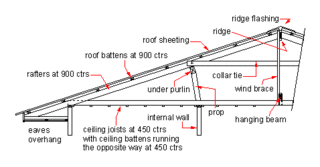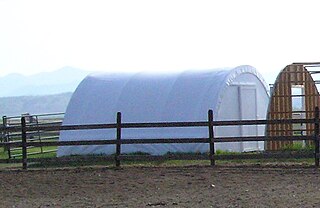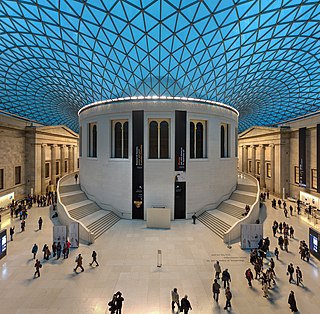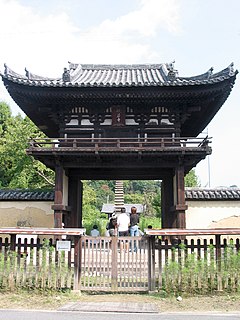
A reciprocal frame is a class of self-supporting structure made of three or more beams and which requires no center support to create roofs, bridges or similar structures.

A reciprocal frame is a class of self-supporting structure made of three or more beams and which requires no center support to create roofs, bridges or similar structures.
Reciprocal roofs tend to be constructed in one of two ways. If built using dimension-ed timber each rafter is usually jointed into the previous one. More commonly these roofs are constructed with roundwood poles where each rafter is laid upon the previous one. In both of these approaches the roof is assembled by installing a temporary central support that holds the first rafter at the correct height. The first rafter is fitted between the wall and the temporary central support and then further rafters are added, each resting on the last. The final rafter fits on top of the previous rafter and under the very first one. The rafters are then tied before the temporary support is removed. The structure is most effective at lower pitches where there is minimal spreading force exerted at the ringbeam most being transferred directly downward. Unless some extra elements are added to create redundancy the structure is only as strong as the weakest element as the failure of a single element may lead to the failure of the whole structure.
The reciprocal frame, also known as a Mandala roof, [1] has been used since the twelfth century in Chinese and Japanese architecture although little or no trace of these ancient methods remain. More recently they were used by architects Kazuhiro Ishii (the Spinning House) and Yasufumi Kijima, and engineer Yoishi Kan (Kijima Stonemason Museum). [2]
Villard de Honnecourt produced sketches showing similar designs in the 13th century [3] and similar structures were also used in the chapter house of Lincoln Cathedral. [4] Josep Maria Jujol used this structure in both the Casa Bofarull and Casa Negre. [5]

In architecture, a cornice is generally any horizontal decorative moulding that crowns a building or furniture element—for example, the cornice over a door or window, around the top edge of a pedestal, or along the top of an interior wall. A simple cornice may be formed just with a crown, as in crown moulding atop an interior wall or above kitchen cabinets or a bookcase.

A truss is an assembly of members such as beams, connected by nodes, that creates a rigid structure.

A dormer is a roofed structure, often containing a window, that projects vertically beyond the plane of a pitched roof. A dormer window is a form of roof window.

Timber framing and "post-and-beam" construction are traditional methods of building with heavy timbers, creating structures using squared-off and carefully fitted and joined timbers with joints secured by large wooden pegs. If the structural frame of load-bearing timber is left exposed on the exterior of the building it may be referred to as half-timbered, and in many cases the infill between timbers will be used for decorative effect. The country most known for this kind of architecture is Germany, where timber-framed houses are spread all over the country.

Vernacular architecture is building done outside any academic tradition, and without professional guidance. This category encompasses a wide range and variety of building types, with differing methods of construction, from around the world, both historical and extant, representing the majority of buildings and settlements created in pre-industrial societies. Vernacular architecture constitutes 95% of the world's built environment, as estimated in 1995 by Amos Rapoport, as measured against the small percentage of new buildings every year designed by architects and built by engineers.

A rafter is one of a series of sloped structural members such as wooden beams that extend from the ridge or hip to the wall plate, downslope perimeter or eave, and that are designed to support the roof shingles, roof deck and its associated loads. A pair of rafters is called a couple. In home construction, rafters are normally made of wood. Exposed rafters are a feature of some traditional roof styles.

A cruck or crook frame is a curved timber, one of a pair, which support the roof of a building, historically used in England and Wales. This type of timber framing consists of long, generally naturally curved, timber members that lean inwards and form the ridge of the roof. These posts are then generally secured by a horizontal beam which then forms an "A" shape. Several of these "crooks" are constructed on the ground and then lifted into position. They are then joined together by either solid walls or cross beams which aid in preventing 'racking'.
A tie, strap, tie rod, eyebar, guy-wire, suspension cables, or wire ropes, are examples of linear structural components designed to resist tension. It is the opposite of a strut or column, which is designed to resist compression. Ties may be made of any tension resisting material.
This page is a glossary of architecture.

Domestic roof construction is the framing and roof covering which is found on most detached houses in cold and temperate climates. Such roofs are built with mostly timber, take a number of different shapes, and are covered with a variety of materials.

A king post is a central vertical post used in architectural or bridge designs, working in tension to support a beam below from a truss apex above.

Tension fabric buildings are constructed using a rigid frame—which can consist of timber, steel, rigid plastic, or aluminum—and a sturdy fabric outer membrane. Once the frame is erected, the fabric cover is stretched over the frame. The fabric cover is tensioned to provide the stable structural support of the building. The fabric is tensioned using multiple methods, varying by manufacturer, to create a tight fitting cover membrane.

The Old Faithful Historic District in Yellowstone National Park comprises the built-up portion of the Upper Geyser Basin surrounding the Old Faithful Inn and Old Faithful Geyser. It includes the Old Faithful Inn, designed by Robert Reamer and is itself a National Historic Landmark, the upper and lower Hamilton's Stores, the Old Faithful Lodge, designed by Gilbert Stanley Underwood, the Old Faithful Snow Lodge, and a variety of supporting buildings. The Old Faithful Historic District itself lies on the 140-mile Grand Loop Road Historic District.

A timber roof truss is a structural framework of timbers designed to bridge the space above a room and to provide support for a roof. Trusses usually occur at regular intervals, linked by longitudinal timbers such as purlins. The space between each truss is known as a bay.

Tessellated roof is a frame and a self-supporting structural system in architecture. A simple ridged roof may inside be a tessellated system. The interlinking shapes are replicated across the moulded surface using curvilinear coordinates, a specific technique with rigid interlinking beams, having characteristics similar to woven fabric. A tessellated roof is one of the most flexible framed systems to design. The measurements and precision are complex and commonly part of a computer-aided design process of production. It is used in a honeycomb geometry form, in the biomes of the Eden Project.

The rōmon is one of two types of two-storied gate used in Japan. Even though it was originally developed by Buddhist architecture, it is now used at both Buddhist temples and Shinto shrines. Its otherwise normal upper story is inaccessible and therefore offers no usable space. It is in this respect similar to the tahōtō and the multi-storied pagoda, neither of which offers, in spite of appearances, usable space beyond the first story. In the past, the name also used to be sometimes applied to double-roof gates.

Daibutsuyō is a Japanese religious architectural style which emerged in the late 12th or early 13th century. Together with Wayō and Zenshūyō, it is one of the three most significant styles developed by Japanese Buddhism on the basis of Chinese models.

Zenshūyō is a Japanese Buddhist architectural style derived from Chinese Song Dynasty architecture. Named after the Zen sect of Buddhism which brought it to Japan, it emerged in the late 12th or early 13th century. Together with Wayō and Daibutsuyō, it is one of the three most significant styles developed by Japanese Buddhism on the basis of Chinese models. Until World War II, this style was called karayō but, like the Daibutsuyō style, it was re-christened by Ōta Hirotarō, a 20th-century scholar. Its most typical features are a more or less linear layout of the garan, paneled doors hanging from hinges, intercolumnar tokyō, cusped windows, tail rafters, ornaments called kibana, and decorative pent roofs.
A post is a main vertical or leaning support in a structure similar to a column or pillar but the term post generally refers to a timber but may be metal or stone. A stud in wooden or metal building construction is similar but lighter duty than a post and a strut may be similar to a stud or act as a brace. In the U.K. a strut may be very similar to a post but not carry a beam. In wood construction posts normally land on a sill, but in rare types of buildings the post may continue through to the foundation called an interrupted sill or into the ground called earthfast, post in ground, or posthole construction. A post is also a fundamental element in a fence. The terms "jack" and "cripple" are used with shortened studs and rafters but not posts, except in the specialized vocabulary of shoring.
This glossary of structural engineering terms pertains specifically to structural engineering and its sub-disciplines. Please see glossary of engineering for a broad overview of the major concepts of engineering.